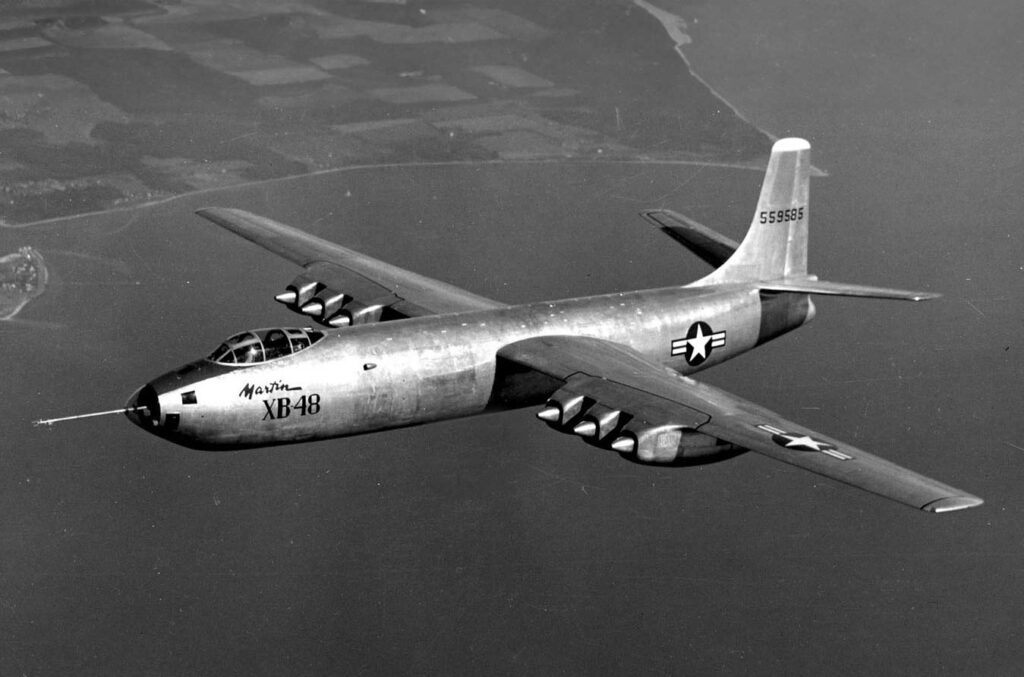The Martin XB-48, an innovative American medium bomber prototype, featured a jet-powered design with a tandem landing gear configuration.
The Martin XB-48 was an experimental medium bomber developed in the United States in the mid-20th century. It was part of the burgeoning jet age and represented a shift in bomber design, focusing on jet propulsion and advanced aerodynamics.
The XB-48 was a response to the increasing need for faster, more efficient bombers in the post-World War II era. It was designed during a period of significant technological advancements in aviation, particularly the transition from propeller-driven to jet-powered aircraft.
History of the Development of the Martin XB-48
The development of the Martin XB-48 occurred in a period marked by rapid advancements in aviation technology. Post World War II, the United States recognized the need for modernized bomber aircraft capable of meeting the demands of the new jet age.
The Martin XB-48 project was initiated in response to a 1944 United States Army Air Forces requirement for a jet-powered bomber. The program was led by the Glenn L. Martin Company, which sought to create an aircraft that could deliver greater speed and range than the propeller-driven bombers of the era.
The first flight of the XB-48 prototype took place on June 22, 1947. This marked a significant step in the development of jet-powered bombers, though the XB-48 ultimately remained a prototype and did not enter full production.
The XB-48 did not receive a NATO nickname as it was developed before NATO standardization of aircraft names and did not enter operational service.
Design of the Martin XB-48
The Martin XB-48’s design was characterized by several innovative features. It was one of the first bomber designs to incorporate jet propulsion, powered by six Allison J35 turbojet engines, arranged in pairs in three nacelles under the wing.
The aircraft’s dimensions included a wingspan of 85 feet (25.91 meters) and a length of 85 feet 6 inches (26.06 meters). Its most distinctive feature was the tandem landing gear arrangement, with two main landing gear units placed one behind the other under the fuselage, a design choice intended to reduce drag.
However, the XB-48 faced several design challenges. The tandem landing gear proved complex and limited the aircraft’s payload capacity. Additionally, the placement of the engines presented maintenance challenges.

Performance of the Martin XB-48
The performance of the XB-48 was reflective of the technological limitations and experimental nature of early jet bombers. The Allison J35 engines provided a top speed of approximately 547 mph (880 km/h) and a service ceiling of 40,500 feet (12,344 meters). The bomber had a projected range of 1,000 miles (1,609 km).
Compared to its contemporaries like the Boeing B-47 Stratojet, the XB-48 was less advanced in terms of speed, range, and operational capabilities. The B-47’s swept-wing design and more efficient engine placement gave it a distinct advantage over the XB-48.
Military Use and Combat of the Martin XB-48
The Martin XB-48 never saw active military service or combat. It remained an experimental prototype and was primarily used for testing and evaluation purposes. The aircraft’s armament capabilities were conceptual and included provisions for a bomb bay capable of carrying a significant payload.
The XB-48 competed with other early jet bomber designs, notably the Boeing B-47 Stratojet and the North American B-45 Tornado. While the XB-48 provided valuable data and insights into jet bomber design, it was the B-47 that ultimately succeeded in becoming the USAF’s primary medium bomber for the early Cold War period.
The XB-48 was not sold to other countries or used in any conflict, given its status as a prototype. It was eventually phased out as more advanced bomber designs like the B-47 entered service.
The Martin XB-48 stands as an important step in the evolution of jet-powered bomber aircraft. While it did not advance beyond the prototype stage, its development contributed valuable insights into jet propulsion, aerodynamics, and bomber design that influenced subsequent aircraft. The XB-48 represents a significant, though often overlooked, chapter in the history of military aviation.
Back to the experimental aircraft section.